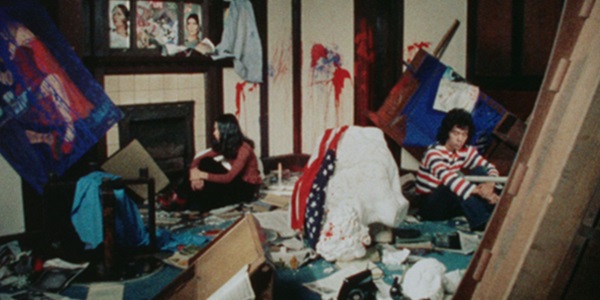Fujisawa Isao began his career as an assistant director to Hiroshi Teshigahara on the landmark Japanese New Wave films Woman in the Dunes and The Face of Another before making his directorial debut with the 1974 independent drama Bye Bye Love. Yet this film—the only narrative feature Fujisawa directed before focusing on television and documentary—was thought to be lost for decades until a negative was discovered in a warehouse by producer Suzuki Akihir in 2018. Now screening in a new restoration as part of a series at Metrograph in New York that also includes those classics mentioned above, Bye Bye Love stands on its own as one of the most vibrant and energetic films of the Japanese New Wave, a queer road trip saga with a portrayal of gender fluidity that stands out for its sensitivity then and now.
My Life to Live
Shot on a richly textured 16mm stock that emphasizes the film’s anarchic aesthetic—complete with bright splashes of red and blue that, combined with the general plot, cannot help but recall Jean-Luc Godard’s Pierrot le Fou—Bye Bye Love begins by introducing us to a freewheeling young man who goes by Utamaro (Tamura Ren). When a lovely young woman crosses his path on the streets and begs him to save her from a pervert who is pursuing her, Utamaro is all too willing to oblige…even when the pursuer is revealed to be a cop who suspects the woman of shoplifting. Now Utamaro is the one pursuing the mysterious figure, whom he dubs Giko (Ichijo Miyabi).

When Utamaro catches up to Giko, he impulsively declares his love…only to discover that while the girl of his dreams presents as female, Giko was born male and identifies in a way that is much more gender fluid. Still, Utamaro’s initial disappointment at this discovery quickly gives way to acceptance and affection. So, when he shoots the American with whom Giko has been cohabitating, the two go on the run together. The whirlwind adventure that follows feels like a last grasp for freedom as the colorful counterculture that Utamaro and Giko exist as part of begins to fade away, replaced by the dull gray of an increasingly conservative world.
In Praise of Love
Bye Bye Love takes all the tropes associated with lovers on the run and gives them an electric jolt to the senses (which also happens to be something that Utamaro and Giko experiment with during an encounter with a sex worker in the latter part of the film). The relationship at the film’s center is largely platonic but no less passionate, with the two of them clinging to each other as though they’re afraid they’ll spin off into outer space if they let go. Until they met, they existed on the margins of society, but now they’re the centers of each other’s worlds. Giko describes it poignantly and succinctly: “It’s like a love triangle…you and the male and female me.”
Tamura and Ichijo bring these two characters to vivid life as they tumble across Japan in stolen cars, trying to outrun the authorities on their tails even as they can’t resist stopping to stare at the wanted posters bearing their visages that pop up along their trail. They acknowledge their desire for each other but don’t act on it in the ways you may expect, which makes sense: their entire existence is a rebellion against what is expected. The malleability of identity is at the heart of Bye Bye Love, which approaches Giko’s gender fluidity with empathy and understanding. Yet while Giko’s questions of identity are more overtly visible than Utamaro’s, both characters struggle with the tension between how others perceive them and how they perceive themselves. In one of the film’s funnier moments, they see a man staring at them and pointedly decide to stare back, making him feel far more uncomfortable under their gaze than they ever could under his. The film echoes their boldness in its creative camera movement, vivid color palette, and occasionally surreal narrative, punctuated with dramatic bursts of organ music and gunfire.
Conclusion
A remarkable queer romance as messy and unpredictable as its protagonists, Bye Bye Love deserves its second chance in the sun.
Bye Bye Love is currently screening at Metrograph as part of Bye Bye Love: Fujisawa Isao and the Japanese New Wave.
Does content like this matter to you?
Become a Member and support film journalism. Unlock access to all of Film Inquiry`s great articles. Join a community of like-minded readers who are passionate about cinema - get access to our private members Network, give back to independent filmmakers, and more.